New Discoveries
 Welcome to the New Discoveries blog! City of San Diego City Clerk Archives staff use this area to upload newly rediscovered documents from San Diego’s history. In their duties, staff often find unique and interesting pieces of history they want to bring to the public. Those documents are uploaded here and then organized into their appropriate Collection, or a new Collection is created. Please check back frequently for fascinating new finds and discoveries!
Welcome to the New Discoveries blog! City of San Diego City Clerk Archives staff use this area to upload newly rediscovered documents from San Diego’s history. In their duties, staff often find unique and interesting pieces of history they want to bring to the public. Those documents are uploaded here and then organized into their appropriate Collection, or a new Collection is created. Please check back frequently for fascinating new finds and discoveries!
Published on
1915 - Yuma Indian Band at the Panama-California Exposition

Download Image
This group photo captured a significant moment at the Panama-California Exposition, featuring the members of the Yuma Indian Band from Arizona. The band members all attended Yuma Indian School. They embarked on a 200-mile journey across challenging terrains including arid deserts and imposing mountains to reach San Diego. Skillfully playing their instruments, they infused the exposition with their unique melodies, enriching the artistic experience and bringing a sense of joy among attendees.
Published on
May 25, 1910 - Clairvoyance and Palmistry
In 1910, Mrs. L. Hampton submitted an application to the City Council for a clairvoyance and palmistry license. Multiple similar applications are also preserved in the archive’s records. Throughout history, people have always been curious about what the future holds, so they can plan and take control of their lives. Careers such as clairvoyants and psychics have since seen a significant growth within the profession since the early 1900s.
Published on
undated – Flying over Torrey Pines
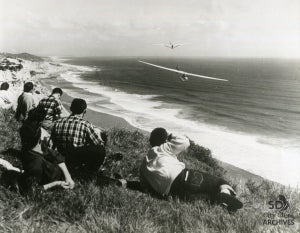
Download Image
The soaring gliders featured in this photo were frequently seen in action at Torrey Pines on weekends. The cliff tops offered such amazing vantage points for spectators. San Diego has a rich history of aviation. Gliding has been a central component of the aviation culture in San Diego over the years. Due to the unique free wind resources, Torrey Pines rapidly developed into a gliderport in the 1930s. The first annual Pacific Coast Midwinter Soaring Championship took place at Torrey Pines in 1947, and this exciting competition persisted until 1979.
Published on
February 15, 1926 - Rat Catcher
In 1926, the San Diego County Medical Society proposed to the City Council to appoint a "rat catcher." Being a port city, San Diego was concerned about the potential escape of plague-infected rats from ships docking at the port. The introduction and spread of diseases such as plague, rat leprosy, and pseudo-tuberculosis were feared consequences. This concern arose after a plague epidemic occurred in Los Angeles between 1924 and 1925, with the disease subsequently spreading from urban rats to rural rodents, becoming established in numerous regions across the western United States.
Published on
January 28, 1916 - Flood in San Diego

Download Image
Check out this photo capturing the aftermath of the January 1916 floods in San Diego. Just before the floods hit, the City Council agreed to pay 'Rainmaker' Charles Hatfield $10,000 if he filled Lake Morena. The floods are still considered the most catastrophic weather event in the history of San Diego, causing the unfortunate loss of 22 lives and the destruction of numerous bridges, roads, and rail lines. The floods also led to the collapse of several dams, resulting in massive waves devastating the communities downstream. The force of the floods caused homes to be swept away by the powerful currents, while downtown San Diego experienced up to five feet of water. Hatfield wasn’t paid a dime.
Published on
March 31, 1939 – Go AZTECS!
San Diego State College, now known as San Diego State University, expressed gratitude to the City Council for their diligent efforts in sending the Aztec basketball team to Kansas City in this 1939 document. The 3rd annual NAIA basketball tournament was held in March at Municipal Auditorium in Kansas City, Missouri. A total of 32 teams participated in the tournament. Our beloved Aztecs placed second, only losing by one point! San Diego takes so much pride in our team, and we continue to support and love them just as much as ever.
Published on
1969 - Waldo Waterman: Soaring in the Sky
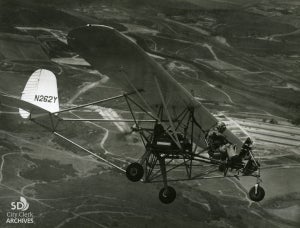
Download Image
Check out this super cool photo! Waldo Waterman drove his Chevy Bird to the San Diego 200th Anniversary Air Show in 1969, at 75 years of age. Can you believe it? He was a real aviation pioneer. Waterman started to build a glider when he was 14 years old in 1909. He even achieved his first successful flight down a canyon near his house in San Diego that same year! In 1912, he enrolled at the University of California at Berkeley to study engineering and then became head of the University's Department of Flight Theory and Military Aeronautics. Additionally, he served as the chief engineer for the U.S. Aircraft Corporation. In 1929, he built the Waterman Whatsit, the first tailless flying-wing monoplane in this country, and the first plane to use the modern version of the tricycle landing gear. Waterman was inducted into the International Air & Space Hall of Fame in 1968.
Published on
April 1, 1878 - Petition of Colonel A. B. Hotchkiss, et al regarding Dobles Brewery on Pueblo Lot No.1161
Since 1877, we have identified breweries in our City’s municipal records. See this beautifully handwritten petition from San Diego County Official, A. B. Hotchkiss that served as the District Attorney (1873-75) asking the honorable Board of Trustees for the proposed work for “Doblers Brewery” to open the road for public street travel. Breweries remain to be a lucrative industry in our ever-growing municipality that continues to support our local economy.
Published on
December 6, 1925 - Communication from F. A. Rhodes, Manager of Operations regarding George W. Marston
See the document regarding George Marston petitioning for permission to purchase land in "Old San Diego,” with a detailed description and a clear map. The work that our City’s pioneers completed, continues to be instrumental in our every day lives.
Published on
undated - Ernestine Schumann-Heink: Legendary Contralto in Her Time
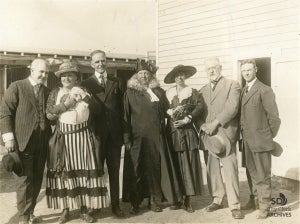
Download Image
Check out this awesome group photo! Can you spot Ernestine Schumann-Heink? She's the second person on the left and she's even holding a rabbit in her hand! Isn't that adorable? Ernestine Schumann Heink (1861-1936) was a renowned contralto singer. Her powerful and emotive voice made her one of the most celebrated opera singers of her time. She gained recognition in America and throughout Europe for her exceptional vocal range and dramatic interpretations. In 1899, Ernestine embarked on a highly successful international tour, captivating audiences worldwide. She became a favorite at the Metropolitan Opera in New York City, performing in operas like Wagner's "Tristan und Isolde" and Verdi's "Aida." Her career spanned several decades, and she retired in 1932 but remained involved in music as a teacher and mentor. She lived most of her life in San Diego since 1911 and was interred in Greenwood Memorial Park after her death.
Published on
April 27, 1909 – Municipal License
Historically, many “peddlers” would petition the City for permission to sell goods on the street.
See the Municipal License from 1909 granting the permission of a Shooting Gallery on 5th Street (now known as 5th Avenue) for the term of six months.
Published on
March 2, 1933 – Communication from Salvation Army
The Salvation Army thanks Honorable Mayor John F. Forward, Jr., and City Council for the appropriation of funds to continue operating the much-needed shelter on Eighth Avenue.
Published on
undated – Tubal Claude Ryan: Embracing the Sky
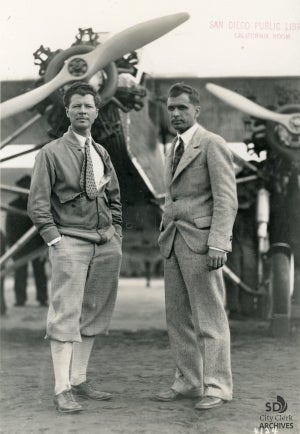
Download Image
The two men standing in front of the Prudden XM-1 trimotor monoplane are T. Claude Ryan (right) and George H. Prudden. Tubal Claude Ryan was a pioneering aircraft manufacturer and founder of aviation factories. In 1922, He established the Ryan Flying Company in San Diego, and provided regularly scheduled flights between San Diego and Los Angeles. The flights departed Los Angeles for San Diego at 9:00 AM, and from San Diego to Los Angeles at 4:00 PM. The fare for a one-way flight was $14.50, and a round trip was $22.50. During the early 1930s he founded the Ryan School of Aeronautics and the Ryan Aeronautical Company. His significant contributions include the design and production of a series of revolutionary aircrafts that were widely utilized in the military.
Published on
May 6, 1889 - Mayor Gunn’s Inaugural Message to the Common Council
Our seventh Mayor writes an inaugural message to the Common Council also referencing the state of our City in this eleven-page valuation. Mayor Gunn addresses topics such as the City Charter and the elections as well as taxpayers deemed as our shareholders, and we are to carry on for the “common advantage” in response to the growth of our City. Mayor Gunn also reflects on fiscal expenditures and the safe-keeping of the City Clerk records in a fire-proof vault in the Archives of the City.
Published on
June 4, 1917 – Two Lifeguards Appointed by the Police Department
Check out the recommendation of appointment regarding the Police Department retaining two lifeguards for La Jolla and Ocean Beach on June 4, 1917. San Diego is renowned for its picturesque beaches as well as the dangers that accompany our ocean waters. Due to the lack of rescue services prior to 1917, thirteen victims drowned on a single day in Ocean Beach. Prior to 1914, the public pursued the appointment of lifeguards. Lifeguards have been promoting public safety since 1917, and the range of services were expansive. During the World War II, City Council arranged draft deferments for seven permanent, fulltime, lifeguards. View Ordinance No. 7014 to see additional budget estimates and allowances for various departments Citywide.
Published on
1931 – City Organization Chart
This is a departmental organizational chart from 1931. Viewing the chart we can see the duties of each position very clearly. In comparison, this is our current City Department Organizational Structure. The evolution of our governments function has shifted our focus from municipal construction to public services.
Published on
undated - Prominent Organists
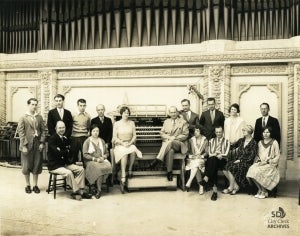
Download Image
These people were the exceptional organists of decades ago. In the middle of the photo sits Ms. Charlotte Speik, the supervisor of Art and Music Section of San Diego Public Library. The background of this photo is the famous Spreckels Organ Pavilion in Balboa Park. The Spreckels Organ Pavilion is the home of the world's largest outdoor pipe organ with over 4,500 pipes. It was constructed for the 1915 Panama-California Exposition and given to the City by brothers John and Adolf Spreckels. The 35th International Summer Organ Festival 2023 (6/26-9/4, Mondays 7:30pm) is being held right now, and you can experience the melodic wonders and witness the remarkable talents of our local musicians.
Published on
October 29, 1915 - Bacteriologist Analyzed City Water
These two documents from 1915 show the Department of Health authorizing a bacteriologist to analyze and report on the City's municipal water daily for public health and safety. The seriousness of the problem can be seen from the words "emergency" and “urgency” that appear in the documents below. Based on the poor sanitary conditions at that time, City water was easily contaminated. Drinking contaminated water can spread many diseases such as diarrhea, cholera, dysentery, typhoid, and polio. Today, we have the Public Utilities Department that constantly filters and purifies our water systems.
Published on
1913 - First Army Air Squadron in San Diego
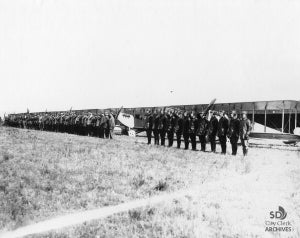
Download Image
This photo shows the First Army Air Squadron organized in United States and assembled in San Diego in 1913. On the extreme right of the line is Commander Benjamin Foulois. This squadron was ordered to the Mexican border in pursuit of Pancho Villa in 1916.
Published on
June 14, 1924 – Forget Me Not
From this petition in 1924, Harry S. Nelson Chapter No. 2 of the Disabled American Veterans of the World War to raise money for veterans’ relief and convention preparation by selling forget-me-nots on Armistice Day. It was a symbol of remembrance for not only those who have given their lives in the service of their country, but for those who survived as well. The country will not forget them, and neither will we.

